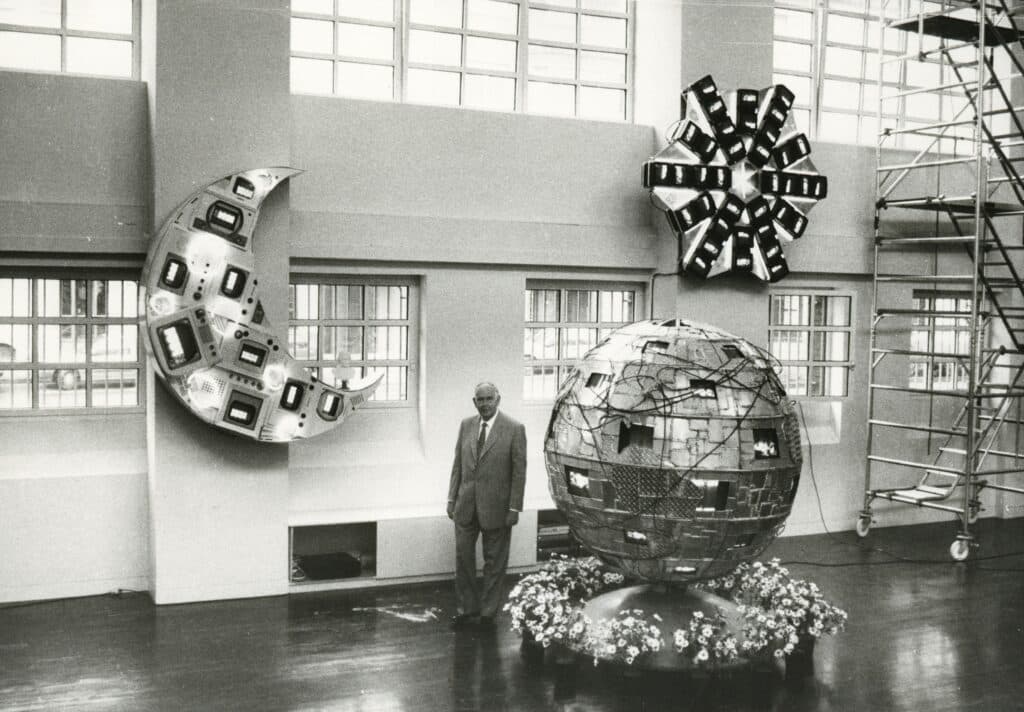The three-part multi-monitor installation Earth, Moon, Sun (1990) by the video artist Nam June Paik (1932 – 2006) is one of the main works in the Aachen collection of Peter and Irene Ludwig. It impressively demonstrates how Paik, who lived in the Rhineland from 1958 to 1963, pushed ahead with the use of new technology as an art form. At the same time, it reflects his great interest in outer space, the planetary system, and space flight, all crucial themes throughout his oeuvre. Acquired by Peter Ludwig in 1991 from the Düsseldorf Gallery Hans Mayer and the first work by the artist to enter the collection, it long occupied a prominent place in the ‘Light Tower’ of the Ludwig Forum.
Earth, Moon, Sun may be seen as symbolizing both the interest in contemporary media art shown by the progressive collectors Peter and Irene Ludwig, as well as Aachen’s reputation as a city of innovation, with the RWTH at the forefront of developments in technology. Nonetheless, the 92 tube televisions embed- ded in the sculptural elements of the work represent a serious challenge to any conservator: the work can only be preserved through regular general overhauls of its technology. Cathode-ray TV screens have not been produced since 2012. Exchanging them for LED sets is out of the question however due to the importance of the installed curved monitors as autonomous compositional elements within the work. Employing flat screens also makes little sense because of their much briefer lifespan. The TVs are currently undergoing an extensive restoration process which shall ensure the work a new usable life expectancy of at least 20 years. Divided into three batches, the monitors are removed from the work and picked up by the CRT-Lab Colorvac, which Christian Draheim runs with the occasional involvement of former Paik assistant Jochen Saueracker, analyzed and given a general overhaul at the ZKM Karlsruhe, and if necessary, fitted with new tubes. To make this final step possible, Saueracker and Draheim have specially developed a new technology for manufacturing cathodes after the end of their industrial production. Another key aspect of restoration concerns the meanwhile porous plexiglass holders used to fasten the neon tubes of the “moon.” In cooperation with the Visual Computing Institute at the RWTH under the direction of Leif Kobbelt, they are reproduced with the aid of 3D printing and possibly replaced by the museum’s conservators.
The open restoration laboratory in the Ludwig Forum Aachen presents this pivot- al aspect of museum work, the care and preservation of works of art, and aims to make it accessible to visitors. Through the work of one of the greatest pioneers of media art, the lab shows the diversity of the technological approaches and the interdisciplinary cooperation needed to conserve time-based art. The lab accompanies the external restoration work in the exhibition space and highlights key aspects: over several months the deconstructed multi-monitor installation will be complemented successively by documents and ephemera concerning its provenance, a film that documents the restoration process in Christian Draheim’s studio, and other video works by Paik from the Forum collection: In addition to six purchases by Peter und Irene Ludwig of works by Nam June Paik following Earth, Moon, Sun, which are now in the Museum Ludwig in Cologne, the City of Aachen’s holdings also include five further video works by Paik from the 1970s thanks to the engagement shown by the Forum’s first director, Wolfgang Becker.
A broad public program will feature experts discussing the work of Nam June Paik and the challenges faced in conserving and restoring media art in general.
Initiated by Eva Birkenstock, realized in close collaboration with Anna Marckwald (curatorial assistant).
Photo: Peter Ludwig in front of the work Earth, Moon, Suninstalled in the Lichthalle during the installation work for the opening of the Ludwig Forum Aachen in 1991, Heinz Lohmann, 1991.

